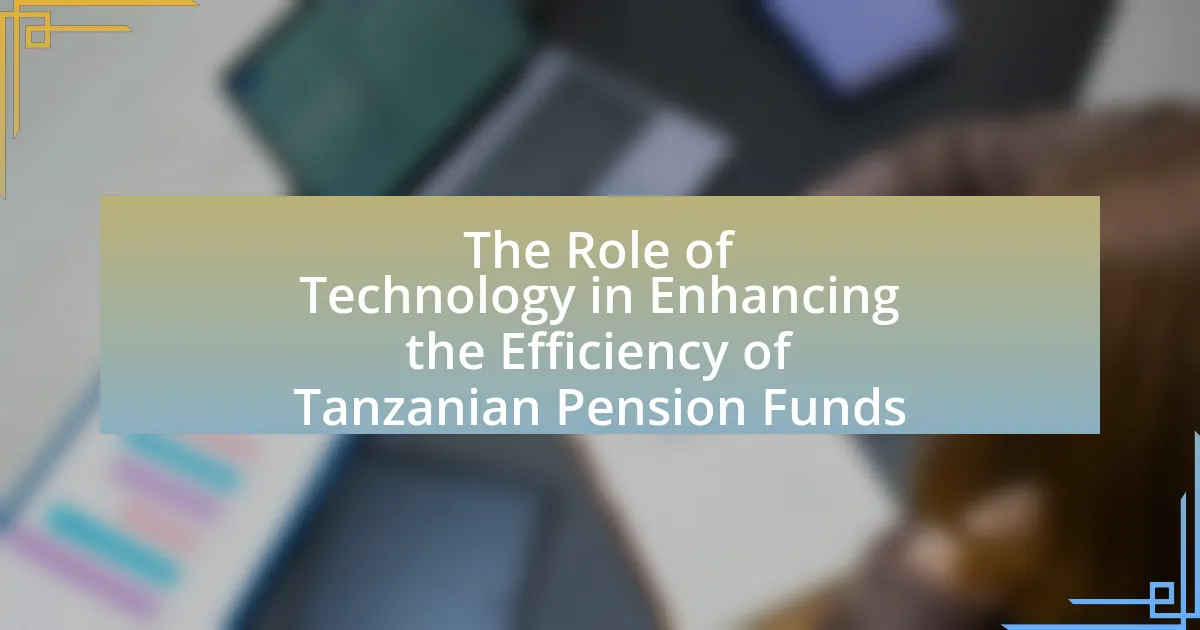Tanzanian pension funds are currently facing significant demographic challenges, primarily driven by an aging population and a high dependency ratio. As the proportion of retirees increases, the financial viability of these pension systems is threatened due to a declining number of contributors. The article examines how population trends, urbanization, migration, and economic factors impact pension fund sustainability in Tanzania. It also discusses strategies for engaging the younger workforce, diversifying investment portfolios, and implementing necessary reforms to ensure the long-term stability of pension funds amidst these demographic shifts.

What are the demographic challenges facing Tanzanian pension funds?
Tanzanian pension funds face significant demographic challenges, primarily due to an aging population and a high dependency ratio. The aging population increases the number of retirees, which puts pressure on pension funds to meet their obligations. According to the National Bureau of Statistics, the proportion of the population aged 60 and above is projected to rise, leading to a greater demand for pension payouts. Additionally, the high dependency ratio, characterized by a large number of dependents relative to the working-age population, complicates the sustainability of pension schemes as fewer workers contribute to the funds while more individuals rely on them for support. These demographic trends threaten the financial viability of pension systems in Tanzania.
How do population trends impact pension fund sustainability in Tanzania?
Population trends significantly impact pension fund sustainability in Tanzania by altering the ratio of contributors to beneficiaries. As the population ages, the number of retirees increases relative to the working-age population, leading to higher payouts and potential funding shortfalls. For instance, Tanzania’s fertility rate has declined from 6.2 children per woman in 1990 to approximately 4.6 in 2021, indicating a shift towards an older demographic. This demographic transition can strain pension systems, as fewer workers are available to support a growing number of retirees, thereby threatening the financial viability of pension funds.
What is the current demographic profile of Tanzania?
The current demographic profile of Tanzania indicates a population of approximately 61 million people, with a median age of around 18 years. This youthful demographic is characterized by a high fertility rate of about 4.6 children per woman and a life expectancy of approximately 65 years. The population is predominantly rural, with about 70% living in rural areas, while urbanization is increasing, particularly in cities like Dar es Salaam. Ethnically, Tanzania is diverse, with over 120 ethnic groups, the largest being the Sukuma. The demographic trends suggest a rapidly growing population, which poses challenges for social services and pension systems, as a larger proportion of dependents may strain resources.
How does aging population affect pension fund liabilities?
An aging population increases pension fund liabilities due to a higher number of retirees drawing benefits for longer periods. As life expectancy rises, pension funds face greater financial strain because they must provide payouts for extended durations, leading to a potential shortfall in available resources. For instance, in many countries, the ratio of workers to retirees is declining, which means fewer contributors are funding the pensions of a growing retired demographic. This demographic shift can result in increased contributions needed from the working population or adjustments in benefit structures to maintain fund solvency.
What role does urbanization play in the challenges of pension funds?
Urbanization significantly impacts the challenges faced by pension funds, particularly in Tanzania, by altering demographic patterns and economic conditions. As urban areas expand, there is often a shift in the workforce from formal to informal employment, which complicates pension fund contributions and coverage. For instance, in Tanzania, approximately 80% of the workforce is engaged in informal sectors, leading to lower participation rates in pension schemes. This shift results in reduced funding for pension systems, as informal workers typically lack access to formal retirement savings plans. Additionally, urbanization can strain public resources and infrastructure, further complicating the financial sustainability of pension funds as they must adapt to a growing population with varying needs.
How does migration influence the pension fund contributions?
Migration influences pension fund contributions by altering the demographic composition of the workforce, which directly impacts the number of contributors and the overall funding levels of pension schemes. When individuals migrate, especially young workers, they may leave behind a shrinking base of contributors in their home country, leading to reduced pension fund inflows. For instance, in Tanzania, significant out-migration of skilled labor can result in a higher dependency ratio, where fewer workers support more retirees, thereby straining pension resources. This demographic shift can lead to a decline in the sustainability of pension funds, as evidenced by studies indicating that countries experiencing high emigration rates often face challenges in maintaining adequate pension contributions to support aging populations.
What are the implications of rural-urban migration on pension fund demographics?
Rural-urban migration significantly alters pension fund demographics by increasing the proportion of younger, urban-dwelling contributors while decreasing the number of older, rural contributors. This shift can lead to a demographic imbalance within pension funds, as younger populations typically contribute less to pension systems compared to older populations who are nearing retirement. For instance, in Tanzania, where rural-urban migration has been prevalent, the urban population growth rate has outpaced rural areas, resulting in a younger demographic that may not yet be fully engaged in pension contributions. Consequently, this can strain pension funds, as they may face challenges in meeting the future payout obligations to an aging population that remains in rural areas, thereby impacting the sustainability and financial health of these funds.
Why is the youth demographic significant for pension fund planning?
The youth demographic is significant for pension fund planning because they represent the future workforce and contributors to pension systems. Engaging this demographic early ensures a stable funding base for pensions, as younger individuals will contribute for a longer period, allowing funds to grow through compounding interest. In Tanzania, where a large percentage of the population is under 30, this demographic’s participation is crucial for the sustainability of pension funds, as it helps mitigate the risks associated with an aging population and ensures that there are enough contributors to support retirees.
What percentage of the population is under 30, and how does this affect pension schemes?
In Tanzania, approximately 60% of the population is under the age of 30. This demographic characteristic significantly impacts pension schemes, as a younger population typically results in a smaller proportion of contributors to pension funds relative to beneficiaries. With a high percentage of individuals under 30, there is a greater reliance on future contributions to sustain pension payouts, which can lead to financial strain on pension systems if the workforce does not grow proportionately or if employment opportunities are limited. This situation necessitates reforms in pension policies to ensure sustainability and adequacy of benefits for an aging population in the future.
How can pension funds engage the younger workforce effectively?
Pension funds can engage the younger workforce effectively by offering tailored retirement plans that align with their financial goals and values. This demographic often prioritizes flexibility and sustainability, so pension funds should incorporate options for socially responsible investments and provide educational resources about the importance of retirement savings. Research indicates that 70% of millennials prefer to work for companies that demonstrate a commitment to social responsibility, which can be leveraged by pension funds to attract younger participants. Additionally, utilizing digital platforms for communication and management can enhance accessibility and engagement, as 85% of younger workers prefer online interactions for financial services.

What are the economic implications of demographic changes on Tanzanian pension funds?
Demographic changes in Tanzania, particularly an aging population and declining fertility rates, significantly impact pension funds’ sustainability and financial health. As the proportion of retirees increases relative to the working-age population, pension funds face heightened pressure to meet their obligations, leading to potential funding shortfalls. For instance, the World Bank reports that by 2050, the elderly population in Tanzania is expected to triple, which will strain the existing pension system that relies on contributions from a shrinking workforce. This demographic shift necessitates reforms in pension fund management, investment strategies, and contribution rates to ensure long-term viability and prevent economic instability.
How does economic growth correlate with pension fund performance?
Economic growth positively correlates with pension fund performance, as higher economic activity typically leads to increased investment returns for pension funds. When the economy grows, companies often experience higher profits, which can boost stock prices and enhance the value of equity investments held by pension funds. For instance, during periods of robust economic growth, such as the global recovery post-2008 financial crisis, pension funds reported significant gains, with average returns exceeding 15% in some regions. This relationship is supported by historical data showing that pension funds tend to perform better in expanding economies compared to stagnant or contracting ones, as evidenced by the performance metrics from the World Bank, which indicate that pension fund returns are closely linked to GDP growth rates.
What economic indicators should pension funds monitor?
Pension funds should monitor economic indicators such as interest rates, inflation rates, employment rates, and GDP growth. Interest rates directly affect the returns on fixed-income investments, while inflation rates impact the purchasing power of pension payouts. Employment rates provide insights into the labor market and potential contributions to pension funds, and GDP growth reflects the overall economic health, influencing investment opportunities and fund performance. Monitoring these indicators helps pension funds make informed investment decisions and manage risks effectively.
How do inflation rates impact pension fund investments?
Inflation rates negatively impact pension fund investments by eroding the purchasing power of future payouts. When inflation rises, the real value of fixed-income investments, which are commonly held by pension funds, declines, leading to lower returns in real terms. For instance, if a pension fund’s investment yields a nominal return of 5% but inflation is at 3%, the real return is only 2%. This discrepancy can significantly affect the fund’s ability to meet its long-term obligations to retirees, especially in environments where inflation is persistently high, as seen in various economies over the past decades.
What are the financial risks associated with demographic shifts?
Demographic shifts pose significant financial risks, particularly for pension funds, as they can lead to an imbalance between the working-age population and retirees. This imbalance can result in increased financial strain on pension systems, as a smaller workforce contributes to a larger pool of beneficiaries. For instance, in Tanzania, the aging population is projected to increase, which may lead to higher pension payouts while simultaneously reducing the number of contributors. According to the World Bank, countries experiencing rapid demographic changes often face sustainability challenges in their pension systems, necessitating reforms to ensure long-term viability.
How can pension funds mitigate risks from changing demographics?
Pension funds can mitigate risks from changing demographics by diversifying their investment portfolios and adjusting their benefit structures. Diversification allows pension funds to spread risk across various asset classes, reducing vulnerability to demographic shifts such as aging populations. For instance, investing in a mix of equities, bonds, and alternative assets can enhance returns and stabilize funding levels. Additionally, adjusting benefit structures, such as increasing retirement age or modifying payout formulas, can help align liabilities with the changing demographic landscape. According to the World Bank, countries with proactive pension reforms, including demographic adjustments, have shown improved sustainability in their pension systems.
What strategies can be employed to ensure financial sustainability?
To ensure financial sustainability, pension funds in Tanzania can implement diversified investment strategies, enhance risk management practices, and improve member engagement. Diversification across asset classes, such as equities, bonds, and real estate, can mitigate risks and optimize returns, as evidenced by studies showing that diversified portfolios tend to outperform concentrated ones over time. Additionally, adopting robust risk management frameworks allows pension funds to identify and address potential financial threats proactively, which is crucial given the demographic challenges posed by an aging population. Finally, increasing member engagement through education and transparent communication can lead to higher contribution rates and better financial planning, ultimately supporting the long-term viability of pension funds.

What strategies can Tanzanian pension funds adopt to address demographic challenges?
Tanzanian pension funds can adopt diversification of investment portfolios as a primary strategy to address demographic challenges. By investing in a mix of asset classes, including equities, real estate, and infrastructure, pension funds can mitigate risks associated with an aging population and fluctuating market conditions. For instance, the National Social Security Fund (NSSF) in Tanzania has been exploring investments in infrastructure projects to generate stable returns, which can help meet the long-term liabilities arising from an increasing number of retirees. Additionally, enhancing financial literacy among members can improve participation rates and contributions, thereby strengthening the fund’s financial base.
How can pension funds diversify their investment portfolios?
Pension funds can diversify their investment portfolios by allocating assets across various asset classes, including equities, fixed income, real estate, and alternative investments. This strategy reduces risk and enhances potential returns by spreading investments over different sectors and geographic regions. For instance, a study by the World Bank indicates that diversification can lower portfolio volatility by up to 30%, thereby improving the risk-return profile for pension funds. Additionally, incorporating alternative investments such as private equity or hedge funds can provide exposure to non-correlated assets, further enhancing diversification.
What types of investments are most suitable for a changing demographic landscape?
Investments in healthcare, technology, and sustainable infrastructure are most suitable for a changing demographic landscape. As populations age and urbanize, there is an increasing demand for healthcare services and innovations, making healthcare-related investments a priority. For instance, the World Health Organization projects that the global population aged 60 years and older will reach 2 billion by 2050, highlighting the need for healthcare solutions.
Additionally, technology investments, particularly in digital platforms and automation, cater to a younger demographic that increasingly relies on technology for daily activities. The International Telecommunication Union reported that over 4.9 billion people were using the internet in 2021, indicating a significant market for tech-driven solutions.
Lastly, sustainable infrastructure investments address the growing concern for environmental sustainability, which is becoming a priority for younger generations. According to the Global Sustainable Investment Alliance, sustainable investment assets reached $35.3 trillion in 2020, reflecting a shift towards responsible investing. These sectors align with demographic trends and present opportunities for growth and stability in investment portfolios.
How can technology enhance pension fund management and outreach?
Technology can enhance pension fund management and outreach by improving data analytics, streamlining operations, and facilitating communication with stakeholders. Advanced data analytics allows pension funds to assess investment risks and returns more accurately, leading to better decision-making. For instance, the use of artificial intelligence can analyze vast amounts of market data to identify trends and optimize investment strategies. Additionally, technology streamlines operations through automation, reducing administrative costs and errors, which is crucial for pension funds managing large volumes of transactions. Furthermore, digital platforms enable better outreach by providing members with easy access to their accounts and educational resources, thereby increasing engagement and understanding of pension benefits. According to a report by the World Bank, digital tools can significantly improve financial literacy and access to pension information, which is essential for enhancing participation in pension schemes.
What role does government policy play in supporting pension funds?
Government policy plays a crucial role in supporting pension funds by establishing regulatory frameworks that ensure their stability and sustainability. These policies include tax incentives for contributions, minimum funding requirements, and guidelines for investment strategies, which collectively enhance the financial health of pension systems. For instance, in Tanzania, the government has implemented policies that promote the formalization of the labor market, thereby increasing the number of contributors to pension schemes, which is essential for maintaining fund solvency and addressing demographic challenges.
What reforms are necessary to improve pension fund viability?
To improve pension fund viability in Tanzania, reforms must focus on enhancing contribution rates, diversifying investment portfolios, and increasing transparency in fund management. Increasing contribution rates can ensure that funds accumulate sufficient capital to meet future obligations, as evidenced by the International Labour Organization’s recommendation that pension systems should aim for a contribution rate of at least 15% of wages. Diversifying investment portfolios can mitigate risks and improve returns, as demonstrated by successful pension systems in countries like Chile, which have adopted a multi-fund approach. Lastly, increasing transparency in fund management can build trust and encourage higher participation rates, as seen in the case of South Africa, where regulatory reforms have led to improved governance and accountability in pension funds.
How can public awareness campaigns improve pension fund participation?
Public awareness campaigns can significantly improve pension fund participation by educating individuals about the benefits and importance of saving for retirement. These campaigns can effectively communicate the long-term financial security that pension funds provide, thereby motivating individuals to enroll. For instance, research indicates that targeted messaging can increase awareness and understanding of pension options, leading to higher participation rates. A study by the International Labour Organization found that countries with robust public awareness initiatives saw a 20% increase in pension fund enrollment within two years. This demonstrates that well-structured campaigns can directly influence individuals’ decisions to participate in pension schemes, addressing the demographic challenges faced by pension funds in Tanzania.
What best practices can be implemented for effective pension fund management?
Effective pension fund management can be achieved through diversification of investment portfolios, regular performance assessments, and adherence to regulatory compliance. Diversification minimizes risk by spreading investments across various asset classes, which is crucial given the demographic challenges facing Tanzanian pension funds, such as an aging population and economic volatility. Regular performance assessments ensure that funds are meeting their financial goals and can adapt to changing market conditions, while compliance with regulations protects the fund’s integrity and builds trust among stakeholders. These practices are supported by studies indicating that diversified portfolios tend to yield better long-term returns, which is essential for sustaining pension payouts.
How can pension funds ensure transparency and accountability?
Pension funds can ensure transparency and accountability by implementing robust governance frameworks, regular audits, and clear communication with stakeholders. Governance frameworks establish clear roles and responsibilities, ensuring that decision-making processes are transparent. Regular audits, conducted by independent third parties, provide an objective assessment of financial practices and compliance with regulations, thereby enhancing accountability. Furthermore, clear communication with stakeholders, including beneficiaries and regulators, fosters trust and ensures that all parties are informed about fund performance and management practices. These measures collectively contribute to a culture of transparency and accountability within pension funds.
What lessons can be learned from other countries facing similar challenges?
Countries facing similar demographic challenges to Tanzania’s pension funds can learn the importance of diversifying funding sources and implementing sustainable investment strategies. For instance, countries like Sweden and Canada have successfully reformed their pension systems by incorporating multi-pillar approaches that combine public, occupational, and private pensions, which enhances financial stability and reduces reliance on a single source. Additionally, these countries have adopted policies to increase the retirement age and encourage longer workforce participation, which helps mitigate the financial strain on pension systems caused by aging populations. Evidence from the OECD indicates that such reforms can lead to improved pension sustainability and better outcomes for retirees, demonstrating that proactive policy adjustments are essential in addressing demographic challenges effectively.





